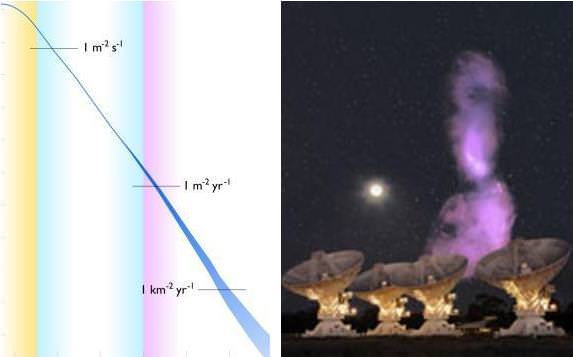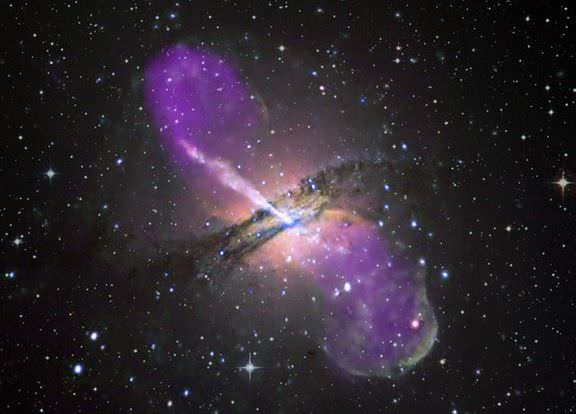[/caption]
Cosmic rays are really sub-atomic particles, being mainly protons (hydrogen nuclei) and occasionally helium or heavier atomic nuclei and very occasionally electrons. Cosmic ray particles are very energetic as a result of them having a substantial velocity and hence a substantial momentum.
The Oh-My-God particle detected over Utah in 1991 was probably a proton traveling at 0.999 (and add another 20 x 9s after that) of the speed of light and it allegedly carried the same kinetic energy as a baseball traveling at 90 kilometers an hour.
Its kinetic energy was estimated at 3 x 1020 electron volts (eV) and it would have had the collision energy of 7.5 x 1014 eV when it hit an atmospheric particle – since it can’t give up all its kinetic energy in the collision. Fast moving debris carries some of it away and there’s some heat loss too. In any case, this is still about 50 times the collision energy we expect the Large Hadron Collider (LHC) will be able to generate at full power. So, this gives you a sound basis to scoff at doomsayers who are still convinced that the LHC will destroy the Earth.
Now, most cosmic ray particles are low energy, up to 1010 eV – and arise locally from solar flares. Another more energetic class, up to 1015 eV, are thought originate from elsewhere in the galaxy. It’s difficult to determine their exact source as the magnetic fields of the galaxy and the solar system alter their trajectories so that they end up having a uniform distribution in the sky – as though they come from everywhere.
But in reality, these galactic cosmic rays probably come from supernovae – quite possibly in a delayed release process as particles bounce back and forth in the persisting magnetic field of a supernova remnant, before being catapulted out into the wider galaxy.
And then there are extragalactic cosmic rays, which are of the Oh-My-God variety, with energy levels exceeding 1015 eV, even rarely exceeding 1020 eV – which are more formally titled ultra-high-energy cosmic rays. These particles travel very close to the speed of light and must have had a heck of kick to attain such speeds.

However, a perhaps over-exaggerated aura of mystery has traditionally surrounded the origin of extragalactic cosmic rays – as exemplified in the Oh-My-God title.
In reality, there are limits to just how far away an ultra-high-energy particle can originate from – since, if they don’t collide with anything else, they will eventually come up against the Greisen–Zatsepin–Kuzmin (GZK) limit. This represents the likelihood of a fast moving particle eventually colliding with a cosmic microwave background photon, losing momentum energy and velocity in the process. It works out that extragalactic cosmic rays retaining energies of over 1019 eV cannot have originated from a source further than 163 million light years from Earth – a distance known as the GZK horizon.
Recent observations by the Pierre Auger Observatory have found a strong correlation between extragalactic cosmic rays patterns and the distribution of nearby galaxies with active galactic nuclei. Biermann and Souza have now come up with an evidence-based model for the origin of galactic and extragalactic cosmic rays – which has a number of testable predictions.
They propose that extragalactic cosmic rays are spun up in supermassive black hole accretion disks, which are the basis of active galactic nuclei. Furthermore, they estimate that nearly all extragalactic cosmic rays that reach Earth come from Centaurus A. So, no huge mystery – indeed a rich area for further research. Particles from an active supermassive black hole accretion disk in another galaxy are being delivered to our doorstep.
Further reading: Biermann and Souza On a common origin of galactic and extragalactic cosmic rays.


Good atrical.
Tahkns
Playe nise!
Gud speling.
One word- spell check!
Five words. I did – what’s the problem?
One way the GZK limit could be breached is if the extremely high energy particle is a neutrino. The SMBH could spin out some extraordinarily high energy particles from the accretion disk, above 10^{20}ev. Some of these particles may interact by weak interactions with material nearby to produce extremely high energy neutrinos. Neutrinos do not interact by electromagnetic interactions and could traverse considerable distances without attentuation from the CMB radiation. These neutrinos could then interact with other particles to generate extremely high energy protons. This might mean extremely high energy cosmic rays from distant sources could reach us in violation of the GZK limit.
LC
@LC (an interesting premise)
These non EM-interacting high energy particles are being created (produced as you said) by weak interactions of some nearby material being acted upon by high energy EM active particles. (to paraphrase your words)
Let us posit the material to be acted upon as a test for this.
What material could provide a ready source for neutrinos — remember this material must also interact energetically with the force provider, those high energy particles ‘from being spun-up’ whose origins are within or nearby the accretion disk which causes the acceleration.
Mary
The high gamma process, here gamma is
? = 1/sqrt{1 – (v/c)^2},
where ? = 10^{10} or greater could be generated by high energy processes near a super-massive black hole. Suppose a proton is brought to this ultra-relativistic energy. If it then interacts with another proton we might have something like
p + p — > n + p +e^+ + ? + mesons.
So long as not too much of this energy is taken up in meson production, the neutron, proton and anti-electron (n, p, e^+) may have modest energy and the neutrino ? can have very high energy. The neutrino is charge-less and does not interact with the electromagnetic field. Consequently it does not interact with the microwave CMB. This neutrino may then enter the Earth’s atmosphere and generate a high energy shower of cosmic ray secondary particles. It might also interact with a particle in interstellar space, in a way similar but reversed to how it was produced and generate an ultra-relativistc proton, which in turn can generate a cosmic ray shower.
The Kerr metric for a rotating black hole has the g_{tt} metric element
? = (r – r_+)(r – r_-)
r_{+/-} = M +/-sqrt(M^2 – J^2}
for M the mass of the black hole and J the angular momentum, both in gravitational units. There are more factors which go into the metric, but I will just consider only this. The r_+ is the outer horizon, which is where the ergosphere exists. The square root of reciprocal of the metric term ~ sqrt{1/?} becomes very large as r — > r_+. So if you have particle interactions which generates a spray of particles then a proton can emerge from the ergosphere with a high gamma. This gamma will be ? ~ 1/sqrt{r – r_+}, which will be very large for protons shot outwards very near the event horizon.
This would be my sense of how such high energy particles might be generated by a SMBH.
LC
But if the neutrino have a very small interaction cross section with CMB photons over vast distances would they not also be extremely unlikely to interact with other particles as well so we could not in a practical sense detect them?
Neutrinos do show up in the Super Kamiokande detector. Admittedly if neutrinos are the source for OMG particles, then the vast majority of them pass through the Earth without so much as a whisper. I am not sure if the Super-K has any data on unusually high energy neutrinos. I did in a quick search and found this:
Tau Air-Showers Signature of Ultra High Energy Neutrinos
Authors: Daniele Fargion
http://arxiv.org/abs/astro-ph/0101565
which contains in the abstract the sentence:
The multiplicity in tau Air-showers secondary particles,N_{opt} =10^{12}, (E_tau}/ PeV, N_{gamma}= 10^8 E_tau/ PeV, N_{e^- e^+}= 2 10^7 E_tau/PeV, N_mu =3 10^5 (E_tau/PeV)^{0.85}, make easy its over-amplified discover. Indeed UHE nu_tau,
This is several orders of magnitude lower than the OMG cosmic ray particle.
I have not read the article because for some reason it does not come up.
LC
Nice find! if this clicks into place it is good times.
Btw on things going “click”, Biermann is prolific, and among other things *everything* is explained by the tested (and even more testable) model. =D
“This original model was thought to produce particles
efficiently above 10^9 eV. Using these arguments allowed
Biermann et al. in several further publications ([15]) to
explain: a) the PAMELA, the ATIC and Fermi data on
CR electrons and CR positrons, b) WMAP haze data
and the 511 keV emission line strength in the Galactic
center region and c) the upturn in the spectra of all cosmic
ray nuclei seen by CREAM (see Stanev et al. [11]).
New Tracer results [16] and further Pamela results [17]
are also consistent in terms of a) the low energy source
spectrum, b) the different spectra for CR-H and CR-He,
c) the energy dependence of interaction, d) a finite residual
path-length at higher energy, and e) a general upturn
in the individual element spectra.”
Indeed, the PRL paper on the CR electron/positron data says in its abstract:
“We attribute the recently discovered cosmic ray electron and cosmic ray positron excess components and their cutoffs to the acceleration in the supernova shock in the polar cap of exploding Wolf-Rayet and red supergiant stars. Considering a spherical surface at some radius around such a star, the magnetic field is radial in the polar cap as opposed to most of 4? (the full solid angle), where the magnetic field is nearly tangential. This difference yields a flatter spectrum, and also an enhanced positron injection for the cosmic rays accelerated in the polar cap. This reasoning naturally explains the observations. Precise spectral measurements will be the test, as this predicts a simple E-2 spectrum for the new components in the source, steepened to E-3 in observations with an E-4 cutoff.”
So, no luck for the electron/positron excess fanbois, it is simply a result of processes analogous to jet production!? Unless that last test fails, of course.